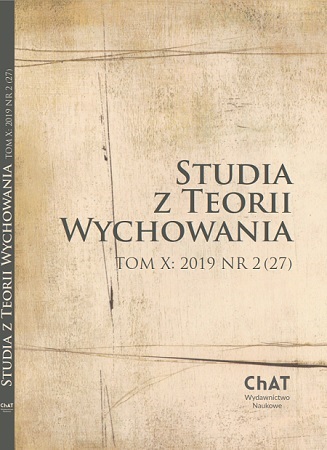Nauczyć i nie zgorszyć. Leszczyński teatr szkolny braci czeskich i luteranów jako medium edukacji – casus dramatu Susanna, ex Danielis 13. tragoedia (1646)
To teach and not to shock. The Czech Brethren’s and Lutherans’ theatre in Leszno as an educational tool – casus of the drama Susanna, ex Danielis 13, tragoedia (1646)
Author(s): Dariusz ChemperekSubject(s): History, Social Sciences, Education
Published by: Wydawnictwo Naukowe ChAT
Keywords: Protestant school theatre; Czech Brethren; Leszno; Nicodem Frischlin; Jan Jerzy Szlichtyng; Bible; Susanna theme
Summary/Abstract: The school theatre in a Protestant gymnasium in Leszno bloomed between 1639 and 1656 thanks to, amongst others, Jan Amos Komenski. One of the plays staged there was a drama Susanna, ex Danielis 13, tragoedia (1646) probably written by Jan Jerzy Szlichtyng who used the virtuous Susanna’s theme from the Bible in an original and yet utilitarian way. The author reduced theological and moral content, present in other adaptations of this theme, in order to focus on showing the stages of court proceedings in Poland, so the young actors – Lesnaeum students – had a chance of gaining some valuable knowledge about the law and practice useful in the court rhetoric in Latin. The first act of the play, being an introduction to the main theme of the play (law and rhetoric in court) was taken by Szlichtyng (?) from a neolatin drama of Nikodem Frischlin, namely Susanna comoedia nova (1577). The comparative analysis of the original and the 17th century’s adaptation leads to a conclusion about the decorum of manners in the Protestant gymnasium. The Polish author removed not only the sexual abuse thread – Susanna strongly molested by the elders and forced to prostitution – but also passages from Frischlin regarding the use of rhetoric in ars amandi, as well as the heroine’s tirades proving her intelligence and scriptural erudition. As a result, the elders’ image has been a little whitewashed and Susanna appears solely as a chaste and noble wife. Such a representation of the heroine – honest but not too sophisticated – and elders – cunning but not too lecherous – was in a harmony with the 17th century’s cultural conventionalities unfamiliar with mulier docta and demanding that youth respects the elderly. Teatr szkolny w protestanckim gimnazjum w Lesznie przeżywał, m. in. za sprawą Jana Amosa Komeńskiego, okres rozkwitu w latach 1639-1656. Jedną ze sztuk wystawianych na tej scenie był dramat Susanna, ex Danielis 13, tragoedia (1646), autorstwa prawdopodobnie Jana Jerzego Szlichtynga, który biblijny motyw cnotliwej Zuzanny opracował w sposób oryginalny a zarazem utylitarny. Autor zredukował treści teologiczne i moralne obecne w innych adaptacjach tego motywu, by odwzorować na scenie etapy rozprawy sądowej w dawnej Polsce, młodzi aktorzy – studenci Lesnaeum – mieli dzięki temu uzyskać wiedzę prawniczą i wyćwiczyć się w wymowie sądowej po łacinie. Pierwszy akt sztuki, będący przedakcją właściwego tematu sztuki (prawo i retoryka w sądzie) przejął Szlichtyng (?) z nowołacińskiego dramatu Nikodema Frischlina Susanna, comoedia nova (1577). Analiza porównawcza oryginału z XVII-wieczną adaptacją prowadzi do wniosków na temat obyczajowego decorum w protestanckim gimnazjum. Polski autor usunął ze swego dramatu nie tylko drastyczne sceny molestowania Zuzanny przez starców i ich propozycje płatnej miłości, lecz także passusy z Frischlina dotyczące zastosowania retoryki w ars amandi oraz tyrady bohaterki, w których wykazuje się ona inteligencją i erudycją biblijną. W efekcie wizerunek starców został nieco „wybielony”, zaś Zuzanna jawi się tylko jako cnotliwa i uczciwa małżonka. Taki obraz bohaterki – prawej, ale nie zanadto uczonej – i starców – podstępnych, lecz nie wyrafinowanych lubieżników – był zgodny z XVII-wiecznymi konwencjami kulturowymi nie respektującymi mulier docta i nakazującymi młodzieży szacunek dla starości.
Journal: Studia z Teorii Wychowania
- Issue Year: X/2019
- Issue No: 2 (27)
- Page Range: 27-46
- Page Count: 20
- Language: Polish

